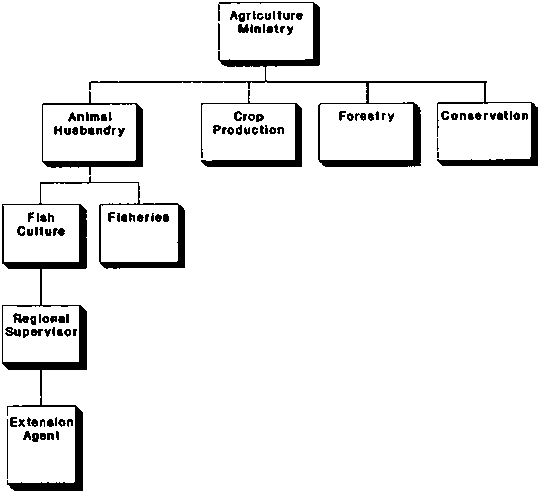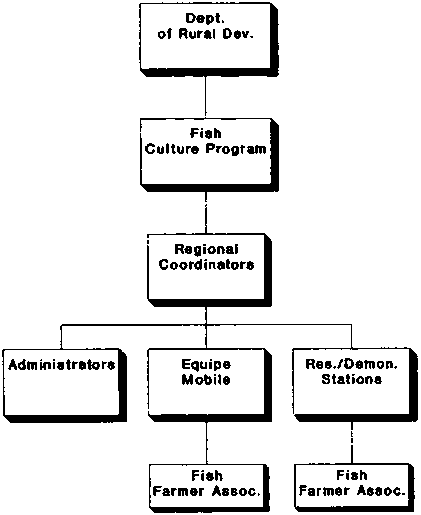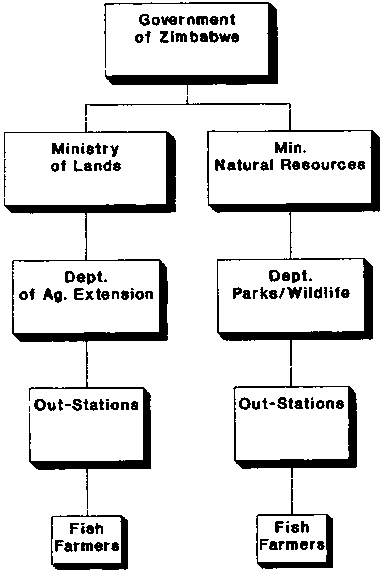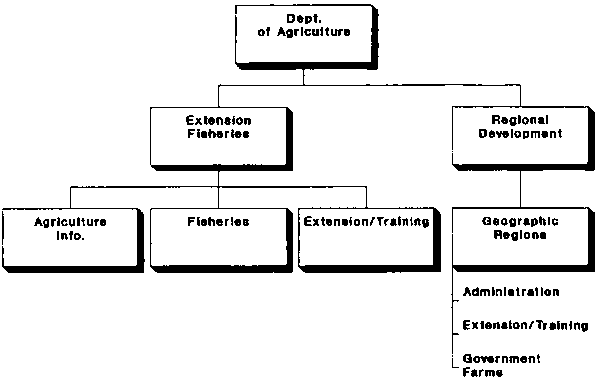ANNEX I - SURVEY INSTRUMENT OF EXTENSION METHODOLOGIES
ANNEX II - ORGANIZATIONAL CHARTS OF AQUACULTURE EXTENSION SERVICES
ANNEX III - ABBREVIATIONS
The layout of the survey has been condensed for reproduction in the Annex.
Compiler
Name:
Mailing Address:
Country:
Telephone:
Position Title:
Relationship to Extension Programme:
1. Which of the following are the principal target groups of your extension programme?
Private producers
Cooperatives
Other (please describe)
Commercial producers
Subsistence farmers
2. Which of the following responsibilities are assumed by your extension personnel?
Formal education (workshops, training, producers' meetings)
Informal education (farm visits)
Transporting production inputs (feed, credit, seed, etc.)
Supplying production inputs (feed, credit, seed, etc.)
Enforcement of regulations (licensing, enforcing fishing regulations)
Other (please describe)
3. To what extent are extension programmes initiated at the local level?
Never
Sometimes
Frequently
4. To what extent are producers involved in planning and programme development?
Never
Sometimes
Frequently
5. Is funding of extension activities controlled at the:
Local level?
Regional level?
National Level?
Other? (please explain)
6. Are extension offices located in the:
Capital city?
Other cities?
Rural areas?
Other? (please explain)
7. Please specify the requirements used in selecting extension agents.
Educational levels
Other training required
Sex
Race
Other (please explain)
8. Are extension agents expected to be generalists and well versed in all aspects of agriculture, or are they expected to be specialized aquaculture personnel?
9. Which of the following extension techniques do you consider appropriate for extension activities directed toward COOPERATIVES?
Training and visit system
Meetings
Mass media
Demonstration farm projects
Educational materials
Other (please explain)
10. Which of the following extension techniques do you consider appropriate for extension activities directed toward PRIVATE PRODUCERS?
Training and visit system
Meetings
Mass media
Demonstration farm projects
Educational materials
Other (please explain)
11. Which of the following extension techniques do you consider appropriate for extension activities directed toward COMMERCIAL PRODUCERS?
Training and visit system
Meetings
Mass media
Demonstration farm projects
Educational materials
Other (please explain)
12. Which of the following extension techniques do you consider appropriate for extension activities directed toward SUBSISTENCE FARMERS?
Training and visit system
Meetings
Mass media
Demonstration farm projects
Educational materials
Other (please explain)
13. Which government agency has primary responsibility for aquaculture extension?
14. What disadvantages result from this agency having responsibility for aquaculture extension?
15. What specific benefits derive from this agency having responsibility for aquaculture extension?
16. Please describe briefly the role that each of the following institutions plays in aquaculture extension in your country.
|
Government agencies |
- Agriculture |
|
|
- Natural Resources |
|
|
- Fisheries |
|
|
- Other |
Universities
Private voluntary agencies (CARITAS, CARE, etc.)
Military
Foreign government agencies (US Peace Corps, etc.)
International agencies (FAO, etc.)
17. Briefly describe how extension and research activities are coordinated, or if they are related.
18. Are there any vehicles for communication between extension agents and researchers in your country?
No
Yes (please describe)
19. Please attach any documents, including organization charts, of how the aquaculture extension effort in your country is organized.
20. What is your overall assessment of the effectiveness of the aquaculture extension structure and methodologies utilized in your country?
Figure 1. Rwanda

Figure 2. Zaïre

Source: Zaïre, Memorandum of Understanding
Figure 3. Zimbabwe

Figure 4. Malaysia

Source: Chakroff, 1982
Figure 5. Nepal

Source: Chakroff, 1982
Source: Chakroff, 1982
|
ADB |
Asian Development Bank |
|
ADCP |
Aquaculture Development and Coordination Programme (UNDP/FAO) |
|
CARE |
Cooperative for American Relief Everywhere |
|
CARI |
Central Agricultural Research Institute (Suakoko, Liberia) |
|
CARITAS |
International Confederation of Catholic Organizations for Charitable and Social Action |
|
FAO |
Food and Agriculture Organization of the United Nations |
|
GTZ |
Deutsche Gesellschaft fur Technische Zusammenarbeit GmbH (Federal Republic of Germany) |
|
IADB |
Inter-American Development Bank |
|
IDRC |
International Development Research Centre (Canada) |
|
IVITA |
Institute Veterinario de Investigaciones Tropicales y de Altura (Peru) |
|
JICA |
Japan International Cooperation Agency |
|
NCRDP |
Nimba County Rural Development Project (Liberia) |
|
NORAD |
Norwegian Agency for International Development |
|
ODA |
Overseas Development Administration (UK) |
|
OXFAM |
Oxford Famine Relief |
|
PC |
Peace Corps (USA) |
|
PVO |
Private Voluntary Organization |
|
SEAFDEC-AQD |
Southeast Asian Fisheries Development Centre - Aquaculture Department (The Philippines) |
|
SIDA |
Swedish International Development Authority |
|
UNDP |
United Nations Development Programme |
|
USAID |
Agency for International Development (USA) |